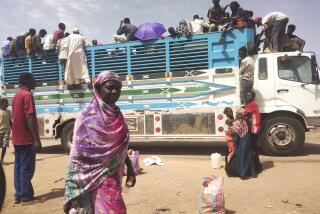U.S. Plans $300 Million in Nicaragua Aid
- Share via
WASHINGTON — The Bush Administration today is expected to unveil a $300-million aid package for Nicaragua to help that nation’s new democratically elected government resuscitate an economy devastated by years of U.S. sanctions and Sandinista rule.
The package, hammered out in principle over the weekend by top Administration policy-makers, also would restore several hundred million dollars’ worth of trade benefits that the United States cut off when it imposed an embargo on Nicaragua in 1985.
U.S. officials said the package contains about $30 million to help resettle the Nicaraguan Contras, the guerrilla group that the United States has supported in an effort to topple the Sandinistas.
Washington also will try to help Managua’s new government finance needed oil imports now that the Soviet Union has announced it no longer will pay for petroleum, as it has during the regime of Sandinista President Daniel Ortega.
The $300 million in cash that the Administration plans to propose for Nicaragua is in line with the requests made by Violeta Barrios de Chamorro, the country’s president-elect, and is about three-fifths the size of the aid package that Washington is giving Panama.
The aid proposal was being put together hastily so it would be ready for Vice President Dan Quayle to announce today as part of his tour through Latin America. Quayle was in Chile on Monday, having attended the inauguration of Chile’s new president, Patricio Aylwin, over the weekend.
Ortega and Quayle met Monday in Santiago, and the outgoing Nicaraguan president promised that he will relinquish power peacefully on April 25, without conditions.
However, the Administration’s plan could run into a technical snag over a longstanding U.S. law that prohibits disbursement of foreign aid to any country that is a year or more behind in repaying previous loans from the U.S. government.
Nicaragua is about $70 million in arrears on loans and credits from the United States for civilian and military purchases.
Washington’s aid to Nicaragua might also be hampered by the fact that the economy has been strangled so thoroughly over the past few years that it is barely functioning. By contrast, Panama had the infrastructure and business skills to resume output almost immediately.
And for all the celebration over Chamorro’s democratic victory, there is widespread apprehension that she may not prove to be enough of a leader to consolidate her gains and run the country.
The aid package being put together by the Administration is certain to be approved easily--and possibly even increased--by the Democratic-led Congress. Lawmakers have indicated they believe aid to Nicaragua should be a high priority in the fiscal 1991 budget.
The United States presumably would insist that Chamorro present a credible plan for putting the country’s economic house in order before any U.S. aid is disbursed. Although Chamorro’s economic advisers have said they intend to put one together, she may lack the political support to do so.
While the sanctions that the United States has imposed on Nicaragua--including a near-total embargo on trade between the two countries--have not left the country completely helpless, they have crimped Nicaragua’s exports and forced it to hunt for substitute markets abroad.
Lance Taylor, a Massachusetts Institute of Technology economist who surveyed Nicaragua’s economy last year, estimates that the embargo has cost the country about $100 million a year in lost trade.
In addition, Nicaragua owes about $250 million in back loans to the World Bank and Inter-American Development Bank--debts that must be paid before new loans from those organizations can be obtained.
Times staff writer David Lauter also contributed to this report.
More to Read
Sign up for Essential California
The most important California stories and recommendations in your inbox every morning.
You may occasionally receive promotional content from the Los Angeles Times.












